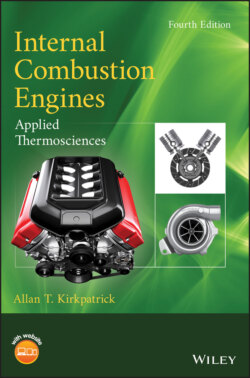Читать книгу Internal Combustion Engines - Allan T. Kirkpatrick - Страница 17
Two‐Stroke Cycle
ОглавлениеAs the name implies, two‐stroke engines need only two strokes of the piston or one revolution to complete a cycle. There is a power stroke every revolution instead of every two revolutions as for four‐stroke engines. Two‐stroke engines are mechanically simpler than four‐stroke engines, and have a higher specific power, the power to weight ratio. They can use either spark or compression ignition cycles. One of the performance limitations of two‐stroke engines is the scavenging process, simultaneously exhausting the burnt mixture and introducing the fresh fuel–air mixture into the cylinder. As we shall see, a wide variety of two‐stroke engines have been invented to ensure an acceptable level of scavenging.
Figure 1.5 A cross‐scavenged two‐stroke cycle.
The principle of operation of a crankcase scavenged two‐stroke engine, developed by Joseph Day (1855–1946), is illustrated in Figure 1.5. During compression of the crankcase scavenged two‐stroke cycle, a subatmospheric pressure is created in the crankcase. In the example shown, this opens a reed valve letting air rush into the crankcase. Once the piston reverses direction during combustion and expansion begins, the air in the crankcase closes the reed valve so that the air is compressed. As the piston travels further, it uncovers holes or exhaust ports, and exhaust gases begin to leave, rapidly dropping the cylinder pressure to that of the atmosphere. Then the intake ports are opened and compressed air from the crankcase flows into the cylinder pushing out the remaining exhaust gases. This pushing out of exhaust by the incoming air is called scavenging.
Herein lies one problem with two‐stroke engines: the scavenging is not perfect; some of the air will go straight through the cylinder and out the exhaust port, a process called short circuiting. Some of the air will also mix with exhaust gases and the remaining incoming air will push out a portion of this mixture. The magnitude of the problem is strongly dependent on the port designs and the shape of the piston top.
Less than perfect scavenging is of particular concern if the engine is a carbureted gasoline engine, for instead of air being in the crankcase there is a fuel–air mixture. Some of this fuel–air mixture will short circuit and appear in the exhaust, wasting fuel and increasing the hydrocarbon emissions. Carbureted two‐stroke engines are used where efficiency is not of primary concern and advantage can be taken of the engine's simplicity; this translates into lower cost and higher power per unit weight. Familiar examples include motorcycles, chain saws, outboard motors, and model airplane engines. However, use in motorcycles is decreasing because they have poor emission characteristics. Two‐stroke industrial engines are mostly diesel, and typically supercharged. With a two‐stroke diesel or fuel injected gasoline engine, air only is used for scavenging, so loss of fuel through short circuiting or mixing with exhaust gases is not a problem.
